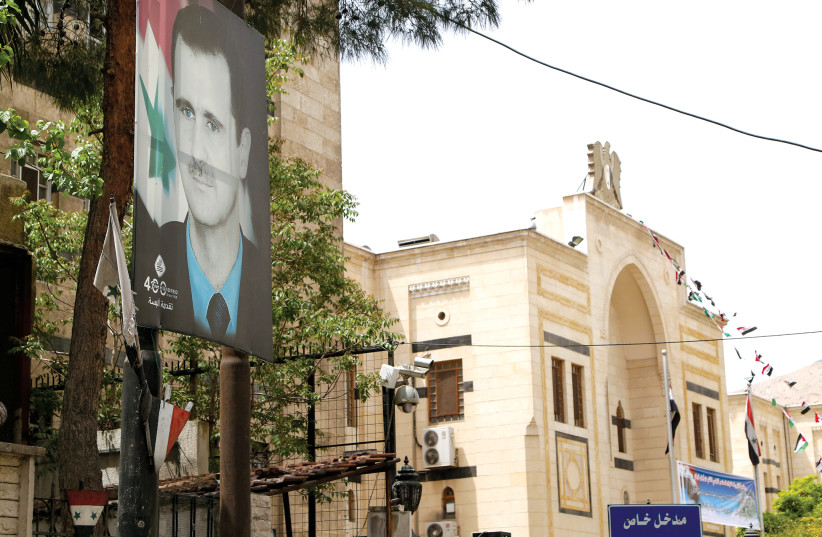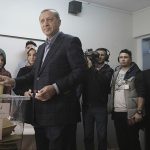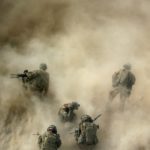The problem is that while these efforts to “normalize” Assad’s status are making some headway on the international level, the situation on the ground in Syria is far from normal. Rather, the Syrian regime is profoundly weak. Foreign powers maintain powerful military and political structures on Syrian soil, controlling territory without any requirement to seek the permission of the nominal government in Damascus for their activities. Most significant of these is the structure maintained by Iran, which was activated on Monday night in the Mayadeen area against US positions close to al-Omar oilfield.
The current direction of events points to the prospect of a kind of “Lebanonization” or “Iraqification” (if that is a word) of Syria; that is, the emergence of a situation in which a weak government in name only exists and is accepted internationally. Beneath this flimsy structure, a powerful, independent Iranian political-military capacity will have freedom of action, control significant territory, and be able to use the nominal central government as a useful cloak for its activities.
Monday night’s events reflect the already existing Iranian hold on significant parts of eastern Syria, and the extent to which the Syrian-Iraqi border remains something of a fiction. The Iranian attacks came in response to US strikes on Iran-aligned militia positions on either side of the border a day earlier. These in turn were a response to a series of militia attacks using drones on US positions in Iraq and Iraqi Kurdistan.
According to Omar Abu Layla, a Syrian journalist who maintains the Deirezzor24 news site, the Iranian attacks on al-Omar were launched from the area of Mayadeen city. The US response, again according to Omar Abu Layla, targeted positions in and around that city. Mayadeen exemplifies the strength of the Iranian hold in this area. It is located along a contiguous stretch of Iranian-controlled territory extending north from the IRGC-controlled international border at Albu Kamal/al-Qaim. Control of Mayadeen and the roads to its south and west enable Iran-aligned forces to avoid the US controlled zone around al-Tanf base when heading further west toward Lebanon and toward the border with Israel.
Security control on the ground in these areas is in the hands of the Iranians and their associated Arab militias. The forces of the Assad regime are able to operate only with Iranian permission. Alongside the military structures, Iran is seeking to entrench itself in the economic life of the area, and to secure the loyalty of the population. Tehran controls significant oil facilities in this area. Most importantly, the T2 station, a vital pumping facility on the Kirkuk-Banyas pipeline, is in the hands of Iran. It has made some inroads into the tribal structures of Deir al-Zur, maintaining good relations with elements of the powerful al-Bagara tribe. Less successful efforts have even been made at promoting Shia Islam among the Sunni Arab population of this area.
Sources in the US-aligned Syrian Democratic Forces, meanwhile, express concern at efforts by the Iranians to penetrate the SDF area of control east of the Euphrates. At present, this zone is the main barrier to de facto Iranian/militia control of the entirety of the Syria-Iraq border.
IRANIAN ACTIVITY also extends west of Deir al-Zur. A recent report on the Levant24 news site identifies areas of Iran-aligned militia control in “large swaths of south rural Idlib, east rural Hama, and north rural Homs.” The site names the (Iraqi) Nujaba, Ktaib Hezbollah, (Pakistani) Zeinabiyun and (Afghan) Fatemiyun militias as the key elements engaged.
The diplomacy on Syria proceeds largely without reference to these realities. Russia is currently engaged in an effort to secure the important goal of channeling all international aid through Damascus. Moscow is threatening to veto the renewal of the UN mandate to keep the Bab al Hawa border crossing on the Turkish-Syrian border open. The crossing provides vital supplies to four million people living in the Turkish and Sunni Islamist controlled zone in northwest Syria.
Russia’s efforts to secure the nominal sovereignty of the Assad regime throughout Syria are not new. Notably, however, additional forces are now engaged in the effort to “normalize” the regime’s position. Specifically, the emergent Arab diplomatic alignment led by the United Arab Emirates and Egypt is similarly committed to restoring Assad’s diplomatic status. Egypt supported Assad throughout the civil war, seeing him as an authoritarian ruler defending his regime against an Islamist insurgency. The UAE and Bahrain reopened their embassies at the end of 2018. Oman similarly restored relations at the end of 2019. Kuwait and Jordan have reopened their embassies.
Egypt in March called for Syria’s return to the Arab League, a decade after its membership was suspended in the wake of the civil war. The UAE, according to regional media reports, has begun to un-freeze Syrian funds held in Emirati banks. The Gulf monarchy is centrally concerned with Sunni political Islam as a threat. It sees Turkey as the main supporter of this trend, and from this point of view, Assad’s Syria constitutes a bulwark. Iraq never broke relations with Syria.
As of now, the US administration remains opposed to these activities. President Joe Biden has maintained the stance of his predecessor, advising against efforts at normalization and maintaining sanctions. Given the administration’s efforts at a return to the JCPOA, however, there are questions as to the firmness of this stance. The previous administration’s strategy of “maximum pressure” on Iran was a natural fit with an effort to maintain the isolation of Assad’s Syria. It remains to be seen if the current firm US stance is maintained. The Biden administration has failed to designate any new targets for sanctions under the Caesar Act. Sanctions were also lifted on two Dubai-based corporations controlled by Syrian businessman Samer Foz last week.
So where is Israel in all this? The diplomatic isolation of the regime is the ideal setting for the continued prosecution of Israel’s air campaign against the Iranian infrastructure in Syria. This campaign is designed to degrade and slow Iran’s efforts, presumably in the hope of reaching deterrence with the Iranian project in Syria, of a type which has arguably been achieved in Lebanon. Further advancement of the Russian and Arab efforts to “normalize” Assad’s status will raise a question mark over the future viability of this campaign. There have been reports of informal, Russian-directed contacts between Israel and Syrian regime officials as part of this effort.
Israeli planners, however, are likely to take note of the inability and/or unwillingness of these parties to curb or prevent the growing reach and capacities of the Iranian project in Syria. “Normalization” for Assad is likely to mean severe complications for Israel. The forces engaged in the growing insurgency against the US in Iraq and Syria do not and will not take instruction from Assad, from Russia or from the Arab states. Their efforts are unlikely to be halted by diplomacy alone.
By JONATHAN SPYER
Source: JP



